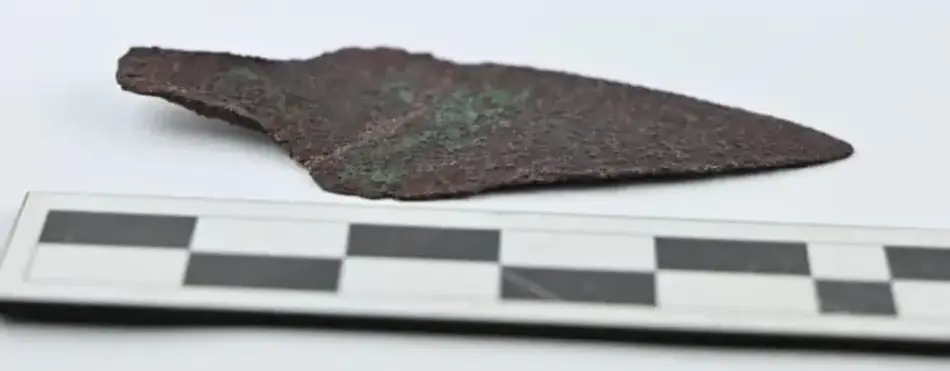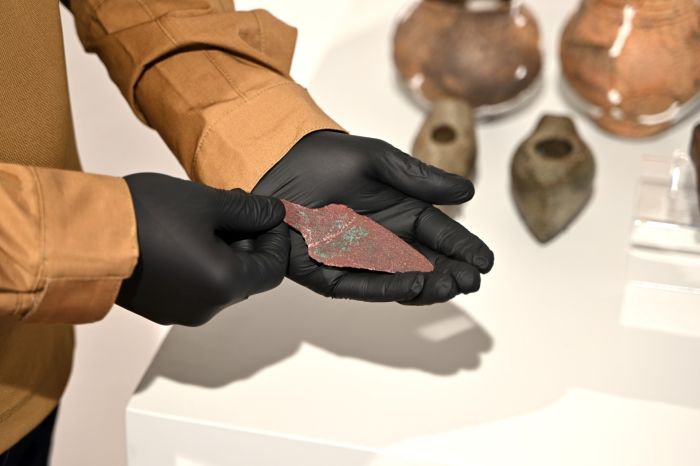4,000-year-old dagger found in Polish forests with the help of a metal detector
- February 25, 2024
- 0
A copper dagger more than 4,000 years old was found in a forest near the city of Jarosław on the San River in southeastern Poland. This find is
A copper dagger more than 4,000 years old was found in a forest near the city of Jarosław on the San River in southeastern Poland. This find is

A copper dagger more than 4,000 years old was found in a forest near the city of Jarosław on the San River in southeastern Poland. This find is the oldest metal dagger found in the Subcarpathian Voivodeship. Archaeologist Dr. from the Yaroslavl Museum. Elzhbeta Seradzka-Burgardt told PAP that copper objects were extremely rare in this region in the 3rd millennium BC.
This valuable object, more than 4,000 years old, was discovered last November by Piotr Gorlach of the Yaroslavl Historical and Research Society, who searched in the forest with the permission of the Regional Conservator of Historical Monuments of the Sub-Carpathian Region in Przemyśl. a metal detector. In the Yaroslavl forest inspection zone near the village of Korzhenytsia.
“I’ve already finished my quest for the day. When I got back to the car, I left the detector on as usual. At one point a signal was heard. As I dug into the forest floor, I saw a flat metal object covered in a green patina. “I quickly realized that I was dealing with something much older than the World War I and World War II military artifacts I was searching for in the area,” Horlach said.
Archaeologists from the Yaroslav Orsetti House Museum identified the artifact as an extremely rare dagger that is 4,000 years old. The ancient weapon was made of copper and was just over 10.5 cm long.

Archaeologist Dr. from the Yaroslavl Museum. According to Marcin Burghardt, the dagger found in Korzhenitsa can be dated to the second half of the 3rd millennium BC.
“On Polish lands, this is a period of great changes, especially in connection with the change of the main raw materials for the production of working tools. Instead of flint tools, which were usually used in the Stone Age, more and more metal products appear, which leads to the next period, namely the Bronze Age “It heralds the transition,” said Dr. Burghardt.
In contrast, archaeologist Dr. from the Yaroslavl Museum. As Elzhbeta Seradzka-Burgardt noted, the dagger discovered at what is now Korzhenitsa was made not of bronze, but of copper.
“It thus predates the development of bronze metallurgy,” the archaeologist said. “In the third millennium BC, objects made of copper were extremely rare, so only people of the highest social status could afford them. There is no doubt that the dagger was not an indigenous product,” added Dr. Burghardt-Sieradzka.
During this period, metal products were imported from modern-day Ukraine or Hungary and were available only to elites who could afford them. Links to the origin of ancient weapons will be established in the future through special metallurgical analysis.
Source: Port Altele
As an experienced journalist and author, Mary has been reporting on the latest news and trends for over 5 years. With a passion for uncovering the stories behind the headlines, Mary has earned a reputation as a trusted voice in the world of journalism. Her writing style is insightful, engaging and thought-provoking, as she takes a deep dive into the most pressing issues of our time.